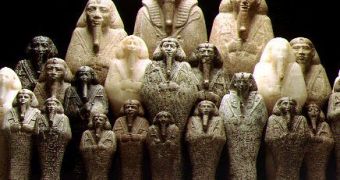Nubia is the name of a region historically located in southern Egypt and northern Sudan, at the gates of Black Africa, stretching from the first cataract to the sixth cataract of the Nile River. The Egyptians called the main Nubia kingdom 'Kush'. Kush was located on the region of the third cataract and was attested since 2,000 BC.
Egypt was better developed, economically and culturally, than Nubia, but Nubia was rich in gold, ivory, cattle and slaves. That's why the Egyptians attempted to conquest Nubia; they did it gradually. Under the 12th dynasty (2,000-1,800 BC) the region up to the second cataract was annexed, and during the New Kingdom (1,600-1,200 BC), the Nubian territory between the first and the fourth cataract is organized as a vice-kingdom. Around 1,500 BC, Kush and its capital Napata were under Egyptian domination, and the Kushan culture and civilization were profoundly influenced by the Egyptian one. The Egyptian god Amon-Re was worshiped by Nubians, who even mimicked Egyptian art and pottery, and used the hieroglyphic writing (but transcribing the Nubian language).The pharaoh Tutmosis II built a temple of this god at Gebel Barkal, temple that would stand for 1,500 years.
To the year 1,000 BC, with the decline of the New Kingdom, the Nubian hostility towards the Egyptians would intensify and the Nubian army led by the king Kashta (745-742 BC) would invade the southern Egypt, founding a dynasty of Nubian pharaohs. This dynasty would unify and rule the whole Egypt. The capital of the new Egyptian kingdom was Napata, where the Nubian pharaohs were crowned.
The other Nubian pharaohs were Piankhi (742-715 BC), Shabaka I (715-701 BC), Shakatak (701-689 BC), Taharka (680-664 BC), and Tanutamun (664-650 BC). They made the 25th dynasty. Nubians were typical African Blacks, and their language (and in the ancient population, the race too) was similar to that of Dinka (from southern Sudan) or Turkana and Masai (of Kenya).
The Black pharaohs built pyramids in the Egyptian style too, but much smaller - with sides of 12 m (40 ft) and heights of 20 m (66 ft). The Nubian pyramids were preceded by chapels. These pyramids can still be seen at the four cataract, near Gebel Barkal.
The invasion of the Assyrian army, in 650 BC, much better armed than the Egyptians, forced the Nubians to retire in their ancient territories, even if, after their victory, the Assyrians withdrew. The Kushan kingdom would stand further, changing its capital from Napata to Meroe, until the 3rd century AD, when it would be destroyed by the Ethiopian army of the Aksum kingdom.

 14 DAY TRIAL //
14 DAY TRIAL //